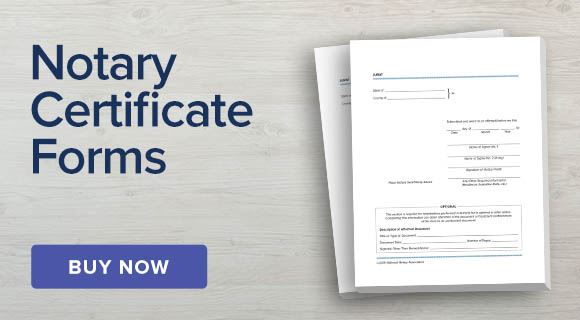
Updated 8-5-24. A core part of a notarization is filling out the notarial certificate — details such as the date, location and signer for the notarial act taking place. If this wording is not printed on the document, you may need to attach a separate certificate form — referred to by some as a “loose certificate." Here are guidelines for when to use or not to use separate certificate wording for a notarization.
When to attach a certificate form
You may need to attach a certificate form to a document in the following circumstances:
When the document contains no certificate wording: This is the most obvious case, since the requirement for Notaries to complete a certificate for each notarization is virtually universal.
Michigan is a special case — it repealed its statutory certificates and instead requires the Notary to add certain specified information after signing a document.
Maryland previously prohibited Notaries from adding a notarial certificate to a document if it didn’t already exist, but that prohibition was removed effective October 1, 2020, under a new state law that requires a Notary to complete a certificate of notarial act for every notarization.
When the certificate does not comply with state requirements: Some states, such as California, have laws prescribing exact certificate wording.
In Hawaii, a rule states that Notaries must include a ‘certification statement’ that is either part of the certificate wording or added to the certificate. In these states, Notaries must ensure the certificate complies with the law and add the correct form or certificate statement if it doesn’t.
When the certificate calls for an act the Notary can’t perform: One example is the act of “signature witnessing,” which Notaries can perform in approximately 20 states. Notaries in states that don’t permit signature witnessing, such as Texas, would have to perform an acknowledgment or oath (or verification) chosen by the signer instead, which would require an acknowledgment or jurat certificate to be added to the document.
When there is no room for the Notary’s seal: Many states have laws requiring a Notary’s seal to be legible, and yet some documents provide insufficient space to affix a legible seal. If the seal will be placed over text or signatures in the document, it’s time to complete and attach a separate certificate form.
When there is no room for the Notary's signature: You may need to fill out and attach a separate Notary certificate if there is no room on the document for your Notary signature.
When there are multiple signers appearing at different times: Sometimes a document may need to be signed in one place and notarized, and then presented to another signer appearing at a different time and place before a Notary for a second notarization. In these cases, a separate certificate must be completed and added to the document because the signers appear separately.
When a Notary makes a mistake: In Florida and California, changes or amendments to a notarial certificate may not be made after the notarization is complete or the signer and Notary have left each other’s presence. Florida Notaries are also required to use photographically reproducible black ink when affixing the seal impression. A Notary who mistakenly places the wrong date in a certificate, for example, may be asked to correct the error by attaching a new certificate to the original document when the signer and Notary meet again.
When there isn’t enough room for the names of all signers: Most certificates have ample space to write in the names of one or two signers having their signatures notarized at the same time. But what if there are several signers and you run out of room? In this case, you’ll have to add a separate certificate to accommodate the names of any signers whose names won’t fit into the original certificate.
Always comply with your state’s Notary requirements
Notaries must follow certain required practices when it comes to using separate certificate forms. This ensures the notarization will be performed correctly and helps prevent someone from fraudulently attaching a “loose certificate” to another document.
Michigan does not prohibit Notaries from attaching a separate certificate form to a document when directed by a client or customer, but it’s not required for the notarization to be performed. The statute simply says that a Notary must write their name exactly as it appears on the Notary commission, date the document, and add the words "Notary Public, State of Michigan, County of (name of county of commissioning)," or if performing the notarization outside of the county of commissioning, "Acting in the County of (name of county where the notarization is performed)." If applicable, the Notary must also include whether the notarial act was performed using an electronic notarization system or performed using a remote electronic notarization platform.
If you live in a state that allows the use of separate certificate forms but doesn’t offer specific guidelines as to how to use them, we recommend the following:
-
Always have the signer determine the type of notarization:
If there is no certificate wording, ask the signer what type of notarization they need because Notaries are not authorized to make this determination. You may describe an acknowledgment, jurat or signature witnessing (if your state allows you to perform signature witnessings), but the signer must ultimately choose.
-
Completely fill out the certificate:
Fill out the separate certificate form as you would any notarial wording appearing preprinted on a document, making sure all of the necessary elements are present, all information is accurate and every space is filled.
If the certificate provides a space for optional information, use this space to describe the document being notarized. The description can read something like this:
"This certificate is attached to a ___________ (title or type of document), dated _____________, of ___ (number) pages, also signed by _____________________ (name[s] of other signer[s] if any)."
This makes it harder for the certificate to be used fraudulently on another document.
-
Staple the certificate to the document:
Once the certificate is completed, the Notary should be the one to attach it to the document. Generally, the certificate should be stapled to the document’s left margin, behind the signature page.
Other fine points regarding ‘loose certificates’
Unless you are a Michigan Notary, you may not place your official seal on a document if notarial wording is missing. If you’re a California Notary, you may not place your seal on a document without the correct notarial wording. If you’re a Florida Notary, you may not complete a certificate that doesn’t contain all of the information required by the law.
While this article has been about when and how to use separate certificate forms, use a separate certificate as a last resort. If at all possible you should make every effort to use the notarial certificate appearing on the document. This will ensure that receiving agencies will accept the notarization without issue.
While some agencies may request it, Notaries should never mail a loose Notary certificate nor rely on someone else to attach it to the document.
Get unlimited access to your state’s Notary certificate forms for free when you become an NNA Member.


Related Articles:
Avoid common Notary certificate mistakes
Common Notary certificate issues explained